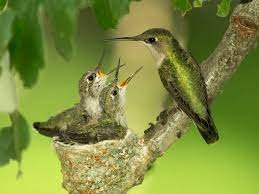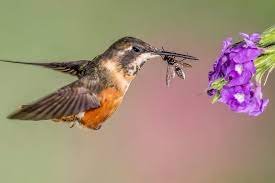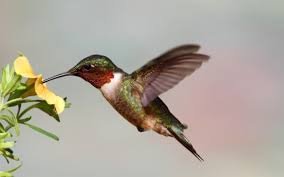The development of a young hummingbird is a miraculous feat of nature. They hatch from the tiniest eggs known to exist. These eggs are smaller than half an inch in length, and they weigh about 0.62 grams. They are so little that they are often compared to jelly beans.
What Time of Year Are Baby Hummingbirds Born?

Breeding season for hummingbirds typically begins in late spring, though this may vary depending on the type of hummingbirds found in a given area. It takes four to five weeks for a chick to develop from an egg to a fledgling, so you can expect them to leave the nest sometime in the warm summer months. Hummingbird nestlings often hatch in the late spring or early summer. It’s possible for a hummingbird’s mother to begin constructing a second nest as she watches over her first.
What is the average time for a hummingbird egg to hatch?

For both eggs to hatch once the female lays them, you need to wait between 15 and 18 days. It could be a few extra days before the chicks hatch if the temperature outside is low.
Also, know How Do Birds Mate?
During incubation, the mother hummingbird will only leave the nest for a few minutes per hour to eat since the eggs must be kept at a temperature of 96 degrees. The male does not participate in nest construction, egg incubation, or chick feeding. Once mating is complete, the female will avoid the male at all costs. Because his brightly colorful feathers could attract predators, of whom there are plenty, it’s possible that she perceives him as a threat.
How many babies will a hummingbird have?

Female hummingbirds can have anywhere from one to three broods per year depending on factors like species, environment, and climate. In most cases, a brood will consist of two eggs, which will hatch into two young hummingbirds.
Typically, the mother will lay her eggs one day apart, but they will all hatch on the same day. Because she won’t begin incubating them both until she lays both, mom has complete control over when they hatch.
If a hummingbird is kind enough to set up housekeeping in a location where you can observe, you might get to see her laying eggs. As she waits for her egg to settle, she will sit on it and wriggle and jiggle it every few seconds.
What does a baby hummingbird look like?

Adult hummingbirds can weigh up to 200 grams, but newly hatched birds weigh just about 60 grams and are completely naked. Their skin can range in color from dark grey to slate to pink. Even inside the same nest, a variety of light and dark hatchlings may coexist. Two thin rows of yellowish-white pinfeathers run along their backs and are the only covering they have (lateral dorsal tract).
There is a small, yellowish bill, and the fleshy regions of the throat and lower mandible might be any hue from orange to red. The egg tooth is absent. The eyes of a newborn hummingbird are closed, but they begin to open around day 7.
As with other birds, hummingbird chicks emerge from their eggs in an immature form and depend on their parents for survival. They are very uncoordinated, yet they can raise their heads when they hear the female meow.
Young hummingbirds’ pinfeathers first appear around the age of 7–8 days, and they do their first wing exercises around the age of 2 weeks. Chicks can pee and poop over the edge of the nest in as little as two or three days.
What do baby hummingbirds eat?

Hummingbird mothers leave their nests to feed on nectar and soft-bodied insects like mosquitoes, gnats, spiders, caterpillars, aphids, insect eggs, fruit flies, and little bees.
Babies and adult hummingbirds alike require protein-rich foods to maintain good health. That protein is provided by insects. In order to rid your yard of pesky insects like mosquitoes, gnats, and aphids, hummingbirds are a welcome guest.
The babies naturally raise their heads and open their mouths when mom returns to the nest because they can feel the wind from her wings. After the insects and nectar have been partially digested, mom will slip her beak into their mouths and regurgitate the food.
How does a mother hummingbird feed her babies?

The young of the species are fed by their mother, who regurgitates a bolus of food, usually insects and nectar, into their beaks. She does this by depositing a pulposus-textured nutrient slurry into her young every 15 to 20 minutes through her crop, which is actually a portion of the esophagus and not the stomach.
To store food for a short time, birds have an organ called the crop, which is essentially an expanded esophagus. This muscled pouch of the bird’s anatomy enlarges at the base of the throat.
When food is plentiful, a mother hummingbird can take advantage of this biological characteristic to quickly collect and store a considerable amount of food in her crop. She can get to her food reserves when she is both secure and prepared to feed her young.
Mother hummingbirds will bob and move their heads and necks up and down, simulating the motion of vomiting, in an effort to regurgitate the undigested food into the waiting beaks of their young.
Where do hummingbird nestlings go?

Hummingbird nests are small, discreet, and well-hidden because of the high risk of predation. Thus, they are typically situated in inaccessible or obscure locations.
When they first leave their nests, they are easily confused with adult females because of their similar appearance and size. It’s likely that you’ve mistakenly identified several male baby birds as females when you’ve really observed them out and about.
Weight of a baby hummingbird
The average weight of a hummingbird chick is about 0.62 grams, but this varies greatly between species. That’s almost equal to a third of the mass of a dime!
What is a baby hummingbird called?
Birdwatchers and ornithologists use a variety of terms to refer to young hummingbirds because no single name has been settled on for them.
- Chicks
- Nestlings
- Hatchlings





